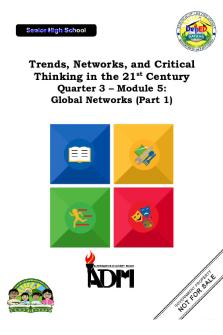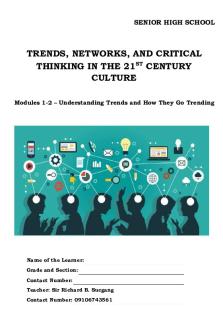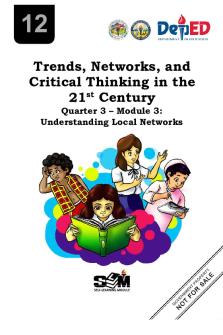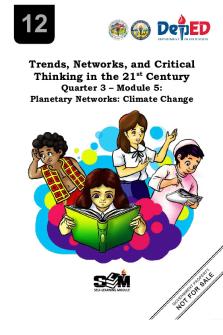Trends Networks and Critical Thinking Module 7 PDF

| Title | Trends Networks and Critical Thinking Module 7 |
|---|---|
| Course | Bachelor of Arts in Sociology (formerly Bachelor of Science in Sociology) (BAS) |
| Institution | Polytechnic University of the Philippines |
| Pages | 20 |
| File Size | 792.2 KB |
| File Type | |
| Total Downloads | 193 |
| Total Views | 1,036 |
Summary
Trends, Networks, and CriticalThinking in the 21st CenturyQuarter 3 – Module 7:Understanding the Consequences ofPersonal and Local Action to Global andPlanetary Climate ChangeiTrends, Networks, and Critical Thinking in the 21st Century – Grade 12 Alternative Delivery Mode Quarter 3 – Module 7: Under...
Description
www.shsph.blogspot.com
Trends, Networks, and Critical Thinking in the 21st Century Quarter 3 – Module 7: Understanding the Consequences of Personal and Local Action to Global and Planetary Climate Change
www.shsph.blogspot.com
Trends, Networks, and Critical Thinking in the 21st Century – Grade 12 Alternative Delivery Mode Quarter 3 – Module 7 : Understanding the consequences of personal and local action to global and planetary climate change. First Edition, 2020 Republic Act 8293, section 176 states that: No copyright shall subsist in any work of the Government of the Philippines. However, prior approval of the government agency or office wherein the work is created shall be necessary for exploitation of such work for profit. Such agency or office may, among other things, impose as a condition the payment of royalties. Borrowed materials (i.e., songs, stories, poems, pictures, photos, brand names, trademarks, etc.) included in this module are owned by their respective copyright holders. Every effort has been exerted to locate and seek permission to use these materials from their respective copyright owners. The publisher and authors do not represent nor claim ownership over them. Published by the Department of Education Secretary: Leonor Magtolis Briones Undersecretary: Diosdado M. San Antonio
SENIOR HS MODULE DEVELOPMENT TEAM Author Co-Author – Language Editor Co-Author – Content Evaluator Co-Author – Illustrator Co-Author – Layout Artist Team Leaders: School Head LRMDS Coordinator
: Mary Claire D. Peña : Rodrigo G. Manuel : Princess L. Gamban : Alma F. Garcia : Cherryl D. Cordova
: Omar G. Magcalas : Cherryl D. Cordova
SDO-BATAAN MANAGEMENT TEAM: Schools Division Superintendent OIC- Asst. Schools Division Superintendent Chief Education Supervisor, CID Education Program Supervisor, LRMDS Education Program Supervisor, AP/ADM Education Program Supervisor, Senior HS Project Development Officer II, LRMDS Division Librarian II, LRMDS
: Romeo M. Alip, PhD, CESO V : William Roderick R. Fallorin, CESE : Milagros M. Peñaflor, PhD : Edgar E. Garcia, MITE : Romeo M. Layug : Danilo S. Caysido : Joan T. Briz : Rosita P. Serrano
REGIONAL OFFICE 3 MANAGEMENT TEAM: Regional Director Chief Education Supervisor, CLMD Education Program Supervisor, LRMS Education Program Supervisor, Regional QA Education Program Supervisor, Regional QA
: May B. Eclar, PhD, CESO III : Librada M. Rubio, PhD : Ma. Editha R. Caparas, EdD : Angelica M. Burayag, EdD : Arnold Montemayor
Printed in the Philippines by Department of Education – Schools Division of Bataan Office Address: Provincial Capitol Compound, Balanga City, Bataan Telefax: (047 ) 237-2102 E-mail Address: [email protected] i
www.shsph.blogspot.com
Trends, Networks, and Critical Thinking in the 21st Century Quarter 3 – Module 7: Understanding the Consequences of Personal and Local Action to Global and Planetary Climate Change
ii
www.shsph.blogspot.com
Introductory Message This Self-Learning Module (SLM) is prepared so that you, our dear learners, can continue your studies and learn while at home. Activities, questions, directions, exercises, and discussions are carefully stated for you to understand each lesson. Each SLM is composed of different parts. Each part shall guide you step-bystep as you discover and understand the lesson prepared for you. Pre-tests are provided to measure your prior knowledge on lessons in each SLM. This will tell you if you need to proceed on completing this module or if you need to ask your facilitator or your teacher’s assistance for better understanding of the lesson. At the end of each module, you need to answer the post-test to selfcheck your learning. Answer keys are provided for each activity and test. We trust that you will be honest in using these. In addition to the material in the main text, Notes to the Teacher are also provided to our facilitators and parents for strategies and reminders on how they can best help you on your home-based learning. Please use this module with care. Do not put unnecessary marks on any part of this SLM. Use a separate sheet of paper in answering the exercises and tests. And read the instructions carefully before performing each task . If you have any questions in using this SLM or any difficulty in answering the tasks in this module, do not hesitate to consult your teacher or facilitator.
Thank you.
iii
www.shsph.blogspot.com
What I Need to Know
Welcome to Module 7! In this Learning Module in Trends, Networks and Critical Thinking in the 21st century you will understand the consequences of personal and local action to global and planetary climate change. Specifically, after working on this module, you are expected to: 1. explain the effects of consumption and production patterns on climate change (HUMSS_MCT12-Ih-i-2); a. list activities that exemplify care for the environment (HUMSS_MCT12Ih-i1); 2. discuss personal contributions that can actually solve the problem of climate change (HUMSS_MCT12-Ih-i-3); and 3. make a stand on how the consequences of one’s action affect the lives of others and the environment (HUMSS_MCT12-Ih-i-4).
1
www.shsph.blogspot.com
What I Know Directions: Identify which among the following terms shows the effects of human consumption and production to climate change. Write E if it is an effect and X if otherwise. Write your answers on a separate sheet of paper. ___________1. tsunami ___________2. greenhouse gasses ___________3. heavy rainfall ___________4. flashflood ___________5. smaller harvest of fruits ___________6. undersized fish caught ___________7. skin cancer ___________8. extensive drought ___________9. terrorism ___________10. earthquake ___________11. melting of glaciers ___________12. heat waves ___________13. rising of sea levels ___________14. wildfires ___________15. more allergies and health risks
2
www.shsph.blogspot.com
Lesson Understanding the Consequences of Personal and Local Action to Global and Planetary Climate Change
1
Have you ever realized that anyone of us can contribute to climate change? The food you eat, the soda you drink, the clothes you wear, and even the sheets of paper you use in answering this module directly or indirectly affect our environment. Human activities are largely responsible for the increase in global temperatures that causes the climate to change. Climate change is real, in fact it is happening now, all you have to do is to open your eyes and be aware of it. This learning module will help you become aware of this worldwide concern on climate change and become more responsible individuals in the use of the earth’s resources.
What’s In
Directions: Using the word GLOBALIZATION, write words, phrases or sentences that you can associate with globalization. Write your answers on a separate sheet of paper. G L O B A L I Z A T I O N
________________________________________________________ ________________________________________________________ ________________________________________________________ ________________________________________________________ ________________________________________________________ ________________________________________________________ ________________________________________________________ ________________________________________________________ ________________________________________________________ ________________________________________________________ ________________________________________________________ ________________________________________________________ ________________________________________________________
3
www.shsph.blogspot.com
What’s New
Directions: Answer the following questions. Write your answers on a separate sheet of paper. 1. Your family is a certified plant lover, that is why you decided to live in a remote area surrounded by different trees and plants. You have observed a factory of furniture in your area. One day you have noticed that the materials they use in their furniture are from the trees near your neighborhood. What is the effect of this situation in your area? As an environmentalist, what will you do to protect the environment near you? ___________________________________________________________________________ ___________________________________________________________________________ ___________________________________________________________________________ ___________________________________________________________________________ ___________________________________________________________________________ ___________________________________________________________________________ ___________________________________________________________________________ __________________________________________________________________________
2. You and your friends decided to eat in a cafeteria near your school. Roxan, one of your friends, ordered a big serving of food. However, she ate only the food she likes and leaves some portion of food she does not like. What is the effect of Roxan’s behavior to the environment? What advice can you give her? ___________________________________________________________________________ ___________________________________________________________________________ ___________________________________________________________________________ ___________________________________________________________________________ ___________________________________________________________________________ ___________________________________________________________________________ ___________________________________________________________________________ __________________________________________________________________________
4
www.shsph.blogspot.com
What is It
The concept of planetary network emphasizes that everything on earth is interconnected. Whatever happens to one element on earth has effect to the other components. Planetary networks refer to the interconnections and interrelations among the various elements in the natural environment enveloping and affecting Earth as well as beyond Earth’s surface. It includes the rain, the wind, the sun’s rays, gasses and other climate-related elements. Global warming is a phenomenon which refers to the rising of global average temperature on Earth’s surface due to the thinning of the ozone layer in E arth’s atmosphere. Ozone stays high up in the atmosphere where it is formed, and its huge quantity is enough to form shield for earth against the sun ’s ultraviolet rays. Ultraviolet rays can cause cornea damage and skin cancer; stunt the growth and food manufacturing process of green plants and destroy the floating microorganisms at the base of the ocean food chain. Global warming causes changes in the climate patterns and weather cycles of the Earth. Climate change refers to the major changes in the climate that last for long periods of time. Climate refers to the prevailing set of atmospheric conditions such as temperature and humidity of a place within a span of time. Weather is the atmospheric condition involving hot or cold, rainy or dry, cloudy or clear sky and stormy or calm in a short period of time (Arzadon et.al 2015).
The Effects of Consumption and Production Patterns on Climate Change Production refers to how people generate and manufacture the products they need to use, sell, or consume. Almost everything comes from natural resources which are depleted every time they are used. If production pattern is characterized by heavy dependence on coal, the problem of climate change will be more aggravated. China, for instance, has large coal mines and relief on them for its energy requirements. This makes China one of the most polluted countries on Earth. Dependence on petroleum in the manufacture and production of goods makes U.S. produced 23 percent of global carbon emission, while it makes eastern European countries, including Russia, produce 14 percent of carbon emission (Harper 2001). These only show that the more progressive the country is, the more they contribute to the depletion of the ozone layer and the worsening of global warming and climate change.
5
www.shsph.blogspot.com
Consumption refers to the use of economic or consumer goods and resources. Consumption patterns can be categorized as individual, family, company and government consumption. It is the main reason why we need to use our resources. Ecosystem has the ability to regenerate, sustain and adjust what is lost, but with the excessive use of land resources, ecosystem will be destroyed. In economics, the more consumption, the more demand, the more demand the more production, the more production the more extraction to natural resources, the more extraction the faster for the resources to destroy. The resources in our environment are limited but the need for production and consumption is unlimited. Some initiatives by the government that helps protect the environment are the following: 1. The Kyoto protocol, which was enforced in 2005, specifies targets and timeframes for reduction of Greenhouse gasses emission of the industrialized countries. For example, United States produces 23 percent of the global carbon emission, from 2000 to 2012 its target reduction is seven percent. 2. The emission certificates guarantee a product’s resource efficiency which can help in increasing sales, decreasing costs and boosting brand loyalty. The certificate enables the manufacturer to gain international recognition for the products. 3. Carbon offsetting is the reduction of carbon footprint by using other options such as wind or solar energy. Simple things you can do to help fight climate change: 1. Save energy Saving energy not only saves you money but helps you cut carbon emissions too. For example, refrain from using your cellphone while charging. 2. Improve your diet When buying fruits and vegetables, try to buy organic. Organic foods are healthier because they contain fewer harmful substances, but growing them also protects the environment and the climate. 3.
Saving water at home Clean water that is pumped to most homes has been treated which uses lots of energy.
4. Recycling It can really help stop climate change because re-using materials usually uses less energy.
6
www.shsph.blogspot.com
5. Compost food scraps If leftovers, peels, cores and cuttings were composted, they would reduce emissions and help protect healthy soil.
6. Plant trees Trees help suck carbon out of the air and stabilize the climate. 7. Avoid plastic wherever you can Almost every plastic is produced from fossil fuels and in every single phase of its life cycle, plastic emits greenhouse gases. 8. Get on your bike Bicycle is still the number one form of sustainable transportation. 9. Be informed and support Support organizations that hold companies to account for the environmental practices. 9. Sharing is caring! If we own less and use more things collectively, we need to produce fewer things and that saves on resources. Sharing cars, exchanging clothes, lending and borrowing tools are multiple different possibilities for collective consumption.
7
www.shsph.blogspot.com
What’s More
A. Directions: Cite three existing problems brought about by climate change that you have observed in your area. Fill in the columns below by writing the reasons why the problems exist and your possible solutions to solve them. Copy the table and write your answers on a separate sheet of paper.
EXISTING PROBLEMS Example: Air Pollution
REASONS WHY IT EXISTS
SOLUTIONS
Too much car in the Use bike instead of car when area going to school.
8
www.shsph.blogspot.com
What I Have Learned Directions: Supply the missing words to complete the paragraph below. Write your answers on a separate sheet of paper. The concept of planetary network emphasizes that everything on 1)__________________ are interconnected. Human actions which transpire in the realm of local networks can produce consequences that penetrate and affect global networks. The depletion of 2)__________________ is caused by human activities primarily the burning of fossil fuels. 3) __________________ is causing alterations in the climate patterns and weather cycles of the earth. The 4)__________________ can provide the legal bases of programs, projects and actions for the protection of the environment and ecosystem. Correcting the wasteful consumption and production patterns is one of the keys to a 5)__________________ and to prevent worsening of climate change.
9
www.shsph.blogspot.com
What I Can Do
Directions: As a responsible senior high school student, your actions are cautious consequences toward the protection of life of others and that of the environment. In this activity, you have to make a plan of action at home by citing five household consumption habits and write across each habit your possible contribution to help solve the climate change . Draw the table below and write your answers on a separate sheet of paper.
CLIMATE ACTION PLAN AT HOME
HOUSEHOLD CONSUMPTION HABITS
CONTRIBUTIONS TO SOLVE CLIMATE CHANGE
Example: Use of disposable mask
Use cloth mask instead
1.
2.
3.
4.
5.
10
www.shsph.blogspot.com
Assessment
Directions: The following are environmental stands of some famous personalities. Choose one from them to reflect upon and write a two-paragraph essay about your choice. Write your answers on a separate sheet of paper. 1. “Earth provides enough to satisfy every man's needs, but not every man's greed.”- Mahatma Gandhi 2. “Saving our planet, lifting people out of poverty, advancing economic growth… these are one and the same fight. We must connect the dots between climate change, water scarcity, energy shortages, global health, food security and women’s empowerment. Solutions to one problem must be solutions for all.” – Ban Ki-moon 3. “The only way forward, if we are going to improve the quality of the environment, is to get everybody involved.” – Richard Rogers 4. “The most important thing about global warming is this. Whether humans are responsible for the bulk of climate change is going to be left to the scientists, but it’s all of our responsibility to leave this planet in better shape for the future generations than we found it.” – Mike Huckabee 5. “A nation that destroys its soils destroys itself. Forests are the lungs of our land, purifying the air and giving fresh strength to our people.” ― Franklin D. Roosevelt RUBRICS FOR ESSAY Adapted from Tuazon, Jenny
5
4
CONTENT The presence of ideas developed through facts, examples, anecdotes, reasons and/or explanations Substantial, specific, and/or illustrative content demonstrating strong development and sophisticated ideas Sufficiently developed content with adequate elaboration or explanation
3
Limited content with inadequate elaboration or explanation
2
Superficial and/or minimal content
STYLE/ CONVENTIONS The choice, use and arrangement of words and sentence structures that create tone and voice Precise, illustrative use of a variety of words and sentence structures to create consistent writer’s voice and tone appropriate to audience Generic use of a variety of words and sentence structures that may or may not create writer’s voice and tone appropriate to audience Limited word choice and control of sentence structures that inhibit voice and tone Minimal variety in word choice and minimal control of sentence structures
11
Similar Free PDFs

Trends Networks Module 4
- 33 Pages

Critical Thinking Assignment 7-4
- 2 Pages

Critical thinking
- 14 Pages

C168 Critical Thinking and Logic
- 16 Pages
Popular Institutions
- Tinajero National High School - Annex
- Politeknik Caltex Riau
- Yokohama City University
- SGT University
- University of Al-Qadisiyah
- Divine Word College of Vigan
- Techniek College Rotterdam
- Universidade de Santiago
- Universiti Teknologi MARA Cawangan Johor Kampus Pasir Gudang
- Poltekkes Kemenkes Yogyakarta
- Baguio City National High School
- Colegio san marcos
- preparatoria uno
- Centro de Bachillerato Tecnológico Industrial y de Servicios No. 107
- Dalian Maritime University
- Quang Trung Secondary School
- Colegio Tecnológico en Informática
- Corporación Regional de Educación Superior
- Grupo CEDVA
- Dar Al Uloom University
- Centro de Estudios Preuniversitarios de la Universidad Nacional de Ingeniería
- 上智大学
- Aakash International School, Nuna Majara
- San Felipe Neri Catholic School
- Kang Chiao International School - New Taipei City
- Misamis Occidental National High School
- Institución Educativa Escuela Normal Juan Ladrilleros
- Kolehiyo ng Pantukan
- Batanes State College
- Instituto Continental
- Sekolah Menengah Kejuruan Kesehatan Kaltara (Tarakan)
- Colegio de La Inmaculada Concepcion - Cebu











